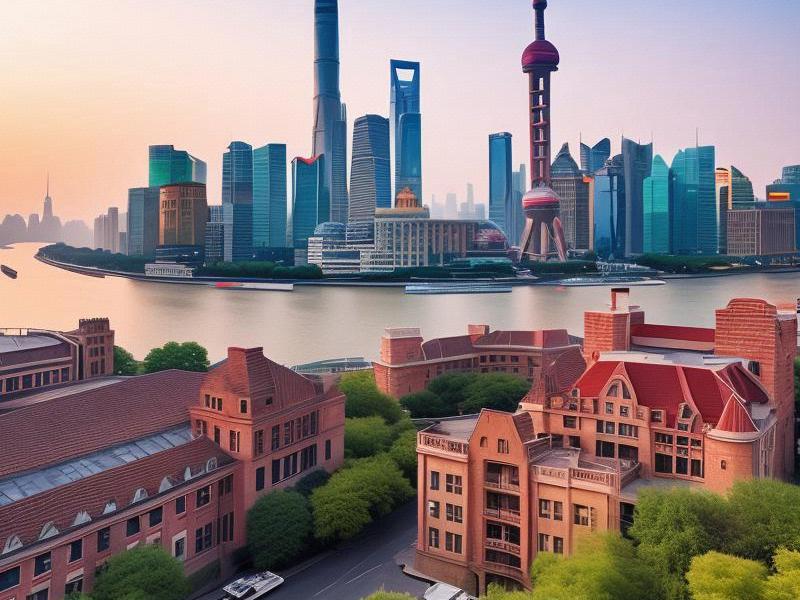This article provides a comprehensive overview of Shanghai and its surrounding areas, exploring the city's urban development, cultural heritage, economic growth, and the unique characteristics of the regions that surround it.

Shanghai, often referred to as the "Pearl of the Orient," stands as a beacon of modernity and tradition in China. As the largest city in the country, Shanghai is a global financial hub, a cultural melting pot, and a testament to China's rapid urbanization. However, the charm of Shanghai is not confined to its bustling streets and towering skyscrapers; it extends to the surrounding areas that offer a blend of natural beauty, historical significance, and economic vitality.
The Urban Marvel of Shanghai
Shanghai's urban landscape is a fascinating blend of the old and the new. The iconic skyline, dominated by the Oriental Pearl Tower, the Shanghai Tower, and the Jin Mao Tower, symbolizes the city's status as a global financial center. The Bund, with its historic architecture and stunning views of the Pudong skyline, is a must-visit for anyone seeking to understand the city's colonial past and its transformation into a modern metropolis.
The city's planning and infrastructure are world-class, with efficient public transportation systems, green spaces, and a commitment to sustainability. The Maglev train, which connects Shanghai to Pudong International Airport, is a marvel of modern engineering, offering a glimpse into the city's forward-thinking approach to mobility.
Cultural Heritage and Historical Significance
Beneath the surface of Shanghai's modernity lies a rich tapestry of cultural heritage. The Yu Garden, a classical Chinese garden built in the Ming Dynasty, offers a serene escape from the city's hustle and bustle. The nearby Yuyuan Bazaar is a vibrant marketplace that showcases traditional Chinese arts, crafts, and cuisine.
爱上海论坛
The French Concession, with its tree-lined streets, European-style villas, and charming cafes, is a living museum of Shanghai's colonial history. The Peace Hotel, once the residence of Western expatriates, is a symbol of the city's cosmopolitan past. These historical landmarks provide a window into the diverse influences that have shaped Shanghai into the unique city it is today.
Economic Growth and Innovation
Shanghai's economy is a powerhouse, driven by its status as a global financial hub, a major port, and a center for trade and commerce. The Pudong New Area, developed in the late 20th century, is a testament to the city's economic ambitions and achievements. Home to the Shanghai Stock Exchange, the World Financial Center, and numerous multinational corporations, Pudong is a symbol of China's economic rise.
The city is also a hub for innovation and technology. Zhangjiang Hi-Tech Park, often referred to as "China's Silicon Valley," is a center for research and development in the fields of information technology, biotechnology, and new materials. Shanghai's commitment to innovation is reflected in its efforts to attract top talent, foster entrepreneurship, and invest in cutting-edge infrastructure.
Surrounding Areas - A Blend of Nature and Culture
上海品茶论坛
The regions surrounding Shanghai offer a diverse range of attractions that complement the city's urban charm. The ancient town of Zhujiajiao, located about an hour from the city center, is a picturesque water town with well-preserved canals, stone bridges, and traditional architecture. Visitors can explore the town's history, enjoy local delicacies, and experience the tranquility of a bygone era.
The scenic Taihu Lake, one of China's largest freshwater lakes, is a popular destination for outdoor activities such as boating, fishing, and hiking. The surrounding area is known for its rich agricultural produce, particularly the famous Taihu peaches and lotus roots. The lake's natural beauty and recreational opportunities make it a favorite among both locals and tourists.
Nanjing, the capital of Jiangsu Province and a city with over 2,500 years of history, is a short train ride from Shanghai. Known as the "Southern Capital," Nanjing is home to numerous historical landmarks, including the Sun Yat-sen Mausoleum, the Ming Xiaoling Mausoleum, and the Confucius Temple. The city's blend of ancient culture and modern development offers a unique perspective on China's rich history.
Suzhou, often referred to as the "Venice of the East," is another neighboring city that captivates visitors with its classical gardens, silk production, and traditional craftsmanship. The Humble Administrator's Garden, one of the most famous gardens in China, is a UNESCO World Heritage Site that showcases the art of Chinese landscape gardening. Suzhou's intricate silk embroidery and beautiful silk products are renowned worldwide.
Environmental Initiatives and Sustainability
上海龙凤419
Shanghai and its surrounding areas are making significant strides in environmental protection and sustainability. The city has implemented various initiatives to reduce pollution, promote green energy, and improve urban living conditions. The Shanghai Greenway Network, a system of parks, bike paths, and pedestrian walkways, provides residents and visitors with opportunities to enjoy nature within the urban environment.
The city's commitment to sustainability is also evident in its efforts to combat climate change. Shanghai has set ambitious targets for reducing carbon emissions and increasing the use of renewable energy sources. The city's green buildings, energy-efficient public transportation systems, and waste management programs are part of its broader strategy to crteeaa more sustainable future.
Conclusion
Shanghai and its surrounding areas offer a unique blend of urban development, cultural heritage, economic growth, and natural beauty. The city's transformation into a global financial hub is a testament to its resilience and adaptability, while its rich cultural heritage and historical landmarks provide a glimpse into its diverse influences. The surrounding regions, with their picturesque landscapes, historical significance, and economic vitality, complement the city's urban charm and offer a diverse range of attractions for visitors and residents alike.
As Shanghai continues to grow and evolve, it remains a symbol of China's rapid modernization and its commitment to sustainability. The city's achievements in urban planning, economic development, and environmental protection serve as a model for other cities around the world. Whether you are drawn to Shanghai's modern skyline, its rich cultural heritage, or the natural beauty of its surrounding areas, there is something for everyone to discover in this dynamic and vibrant region.